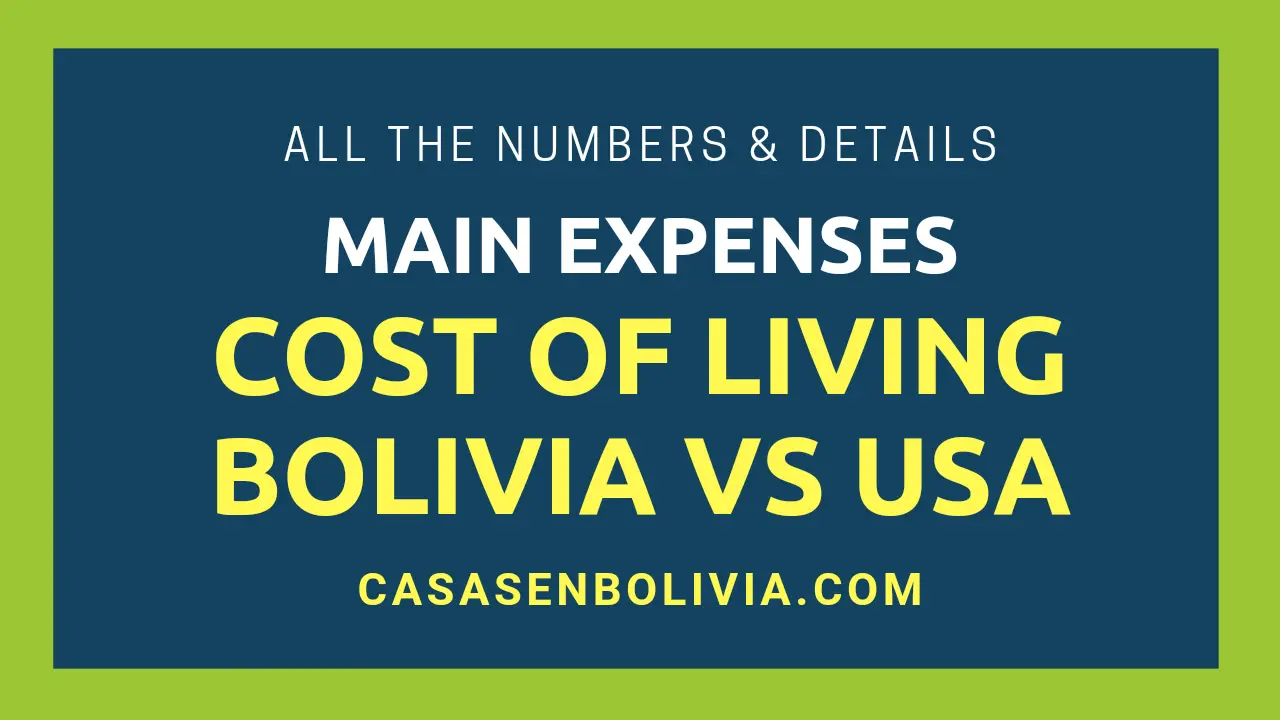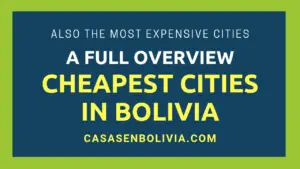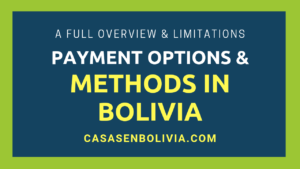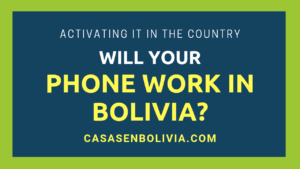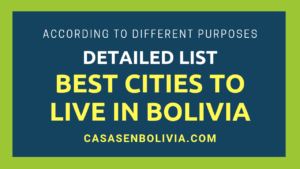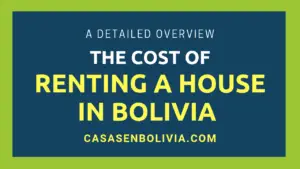Last Updated on February 14, 2025
Living in Bolivia is significantly more affordable than living in the United States if you aim to maintain a comparable standard and quality of life. While lower- and middle-class Bolivians can live on around $500 per person per month without experiencing significant hardship, to achieve a lifestyle similar to that of an upper-middle-class American, you’d need to spend approximately $1,500 to $2,000 per month.
The average cost of living in Bolivia is ~$491 per month, nearly 1/10th of the average cost in the US, which is $5,101 per month. To achieve a standard of living in Bolivia comparable to that of an average US citizen, the average cost of living is $1,742. Therefore, to live in Bolivia as you would in the US, you’ll need around $1,742.
In this article, we’ll provide a detailed breakdown of the cost of living in Bolivia. We’ll compare the expenses of Bolivian citizens with those of people from overseas, considering their income levels and accustomed lifestyles. We are Bolivian real estate experts (website) who have lived in Bolivia our entire lives, and we assist many Bolivians with their real estate projects.
Summary: Cost of Living for Americans vs. Bolivians
To effectively compare the cost of living for Americans and Bolivians, we need to make two distinct comparisons:
- The raw cost of living for both Bolivians and US citizens.
- The cost of living required to match the standard of living of both Bolivians and US citizens.
It’s important to note that while a lower- to middle-class Bolivian (representing over 70% of the Bolivian population) can cover their monthly expenses with around $500 per month, *this doesn’t equate to the same standard of living* as an average person in the US. Instead, this Bolivian’s lifestyle would be closer to that of a lower-income US citizen.
However, an upper-middle-class Bolivian, who spends approximately $1,750 per month to cover all their expenses, *would have a standard of living closer* to that of a middle-class or average American.
Therefore, if you want to live in Bolivia with a $500 monthly budget, your lifestyle will be comparable to that of a lower-income American. However, if you want to maintain a standard of living in Bolivia similar to that of an average American, you’ll need to live like an upper-middle-class Bolivian and have an average cost of living of approximately $1,750 per month, as shown in the table below.
| Type of Cost | Avg. Spending in Bolivia (1 person) | Avg. Spending in the US (1 person) | Upper-Middle-Class Bolivian Spending (1 person) |
| Food & Beverages | $70 | $660 | $150 |
| Housing and Lodging | $150 | $1,674 | $250 |
| Apparel & Clothing | $22 | $156 | $50 |
| Transportation | $50 | $813 | $150 |
| Medical Care & Health | $30 | $414 | $100 |
| Education & Communication | $25 | $117 | $290 |
| Other Goods & Services | $50 | $345 | $150 |
| Total Expenses | $427 | $5,101 | $1,490 |
You can see that to cover all basic monthly expenses in Bolivia, including food, housing, healthcare, education, etc., excluding pension costs, you can live very comfortably on less than $1,500 per month. With this budget, you’ll be able to afford a home in a desirable neighborhood, quality food, decent clothing, adequate healthcare, and so on. In summary, you’ll experience a standard of living very close to that in the United States, but in Bolivia.
On the other hand, if you want to live like an ordinary Bolivian, with numerous restrictions, needing to purchase everything in informal markets, with limited access to quality healthcare, education, and transportation, and residing in less desirable areas, you’ll need only $500 per month per person.
Breakdown: Cost of Living for Americans vs. Bolivians
Next, we’ll provide a detailed breakdown of the cost-of-living components for both Bolivians and Americans.
1) Food and Groceries
Food in Bolivia is very inexpensive compared to prices in the US, regardless of whether you purchase it in open-air grocery markets, informal markets, or supermarkets. This is because Bolivia produces its own food in rural areas, which are very close to urban centers. Additionally, labor costs are very low in rural areas. Furthermore, food in Bolivia is generally healthy and organic.
If you prioritize cost savings, *with only $50 per month*, you can purchase all the groceries needed for one person. However, this reflects the lifestyle of a lower-income or middle-class Bolivian.
However, upper-middle-class Bolivians typically purchase groceries and food at supermarkets and restaurants, or they utilize delivery services. They also tend to hire household staff to prepare their meals.
An average Bolivian will spend approximately $70 per month on food. An upper-middle-class Bolivian will spend around $150, obtaining a similar quality of food as an average American in the US.
| Type of Cost | Avg. Spending in Bolivia (1 person) | Avg. Spending in the US (1 person) | Upper-Middle-Class Bolivian Spending (1 person) |
| Food & Beverages | $70 | $660 | $150 |
| Meal in a Restaurant | $3 | $30 | $7 |
| Fruit Juice (1 glass) | $0.80 | $3 | $1.50 |
| Milk (1 liter) | $0.50 | $0.90 | $0.60 |
| Loaf of Bread (1 portion) | $0.07 | $0.50 | $0.07 |
| Red Meat (1 pound) | $4.50 | $8 | $5 |
| Rice (1 pound) | $0.60 | $2.20 | $0.90 |
| Apple (1 unit) | $0.15 | $0.60 | $0.20 |
| Banana (1 unit) | $0.04 | $0.20 | $0.05 |
| Orange (1 unit) | $0.07 | $0.70 | $0.10 |
| Potatoes (1 pound) | $0.31 | $1.50 | $0.40 |
2) Housing
Housing in Bolivia is also very affordable compared to the United States. *In a very exclusive neighborhood*, a small one-bedroom apartment can be rented for as little as $250 to $350. However, Bolivians from lower and middle classes typically rent in standard and less desirable neighborhoods, with costs ranging from $100 to $150 per person.
In these so-called “exclusive neighborhoods” in Bolivia, you’ll experience a lifestyle similar to that of a typical suburban area in the United States, with well-maintained houses and modern designs. All essential services and amenities will be available to you. These neighborhoods are also very safe, and you’ll find many expats from developed countries residing there.
The average price of a house in Bolivia is $150,000. In the best neighborhoods (Urubo or Las Palmas in Santa Cruz, Calacoto or San Miguel in La Paz, Cala Cala or Queru Queru in Cochabamba), the average price will be $500,000, *but these are the most desirable neighborhoods in Bolivia*.
If you’re relocating to Bolivia, we recommend living in these neighborhoods, as you can see in our dedicated article: Where do expats live in Bolivia? A complete guide.
An average Bolivian will spend approximately $150 per month on housing. An upper-middle-class Bolivian will spend around $250, obtaining a similar quality of housing as an average American in the US.
| Type of Cost | Avg. Spending in Bolivia (1 person) | Avg. Spending in the US (1 person) | Upper-Middle-Class Bolivian Spending (1 person) |
| Housing | $150 | $1,674 | $250 |
| 1-Bedroom Apartment | $150 | $1,250 | $250 |
| 3-Bedroom Apartment | $250 | $2,200 | $500 |
| Renting a House | $500 | $3,900 | $1,500 |
| Mortgage on a $100,000 House | $710 | $480 | $710 |
| Average House Sale Price | $150,000 | $300,000 | $500,000 |
3) Apparel
Most Bolivians tend not to spend excessively on clothing and apparel. They are also accustomed to keeping their clothes for years, often more than three years. They frequently purchase clothing at informal markets and open-air markets, where you can find pants for as little as $3 and sneakers for $20. *However, this reflects the habits of lower- and middle-class Bolivians.*
In contrast, upper-middle-class Bolivians tend to purchase high-quality, branded clothing from specialized clothing stores. They also tend to buy more clothes for different and special occasions and replace their apparel more frequently. Even so, you’ll find that clothing expenses are significantly lower in Bolivia compared to the US, while maintaining similar quality and, in many cases, the same brands.
If you want a single high-quality, branded outfit in Bolivia, you’ll spend around $100; *this includes everything except shoes*. A high-quality, branded pair of shoes will cost around $50. You’ll find these items in dedicated stores and experience a shopping environment similar to that of a developed country.
An average Bolivian will spend approximately $22 per month on apparel. An upper-middle-class Bolivian will spend around $50, obtaining a similar quality of apparel as an average American in the US.
| Type of Cost | Avg. Spending in Bolivia (1 person) | Avg. Spending in the US (1 person) | Upper-Middle-Class Bolivian Spending (1 person) |
| Apparel | $22 | $156 | $50 |
| 1 Outfit | $40 | $150 | $100 |
| 1 Pair of Shoes | $20 | $67 | $40 |
| 1 Sweater | $10 | $40 | $20 |
| 1 Pair of Pants | $7 | $34 | $15 |
| 1 Suit | $40 | $180 | $90 |
4) Transportation
The average Bolivian citizen doesn’t own a car, not even the average Bolivian family. The majority of Bolivians rely on public transportation to travel from one place to another. They are also not accustomed to flying for domestic travel; they almost always travel by land.
*However, this is not the case for upper-middle-class Bolivians*. These individuals typically own at least one car for the entire family, and many family members have their own vehicles. Also, these individuals typically purchase cars in the $10,000 to $25,000 price range, usually with bank loans. They also travel more frequently to other locations, primarily by air. A taxi ride in Bolivia costs around $3 per trip. Gasoline in Bolivia currently costs around $2 per gallon, as it is partially subsidized by the government.
You also need to be aware that in some Bolivian cities, owning a car is not strictly necessary for getting around. This is the case in La Paz, where everything is relatively close, similar to the metro area of New York. In contrast, other cities like Santa Cruz are very spread out, and you’ll need a car most of the time. In Bolivia, a $20,000 car will provide a very comfortable experience.
An average Bolivian will spend approximately $50 per month on transportation. An upper-middle-class Bolivian will spend around $150, obtaining a similar quality of transportation as an average American in the US.
| Type of Cost | Avg. Spending in Bolivia (1 person) | Avg. Spending in the US (1 person) | Upper-Middle-Class Bolivian Spending (1 person) |
| Transportation | $50 | $813 | $150 |
| Car Price | $8,000 | $42,000 | $25,000 |
| Gas Cost (1 gallon) | $1.80 | $3.67 | $1.80 |
| Car Parking (1 hour) | $0.70 | $5 | $1 |
| Car Monthly Loan Payment | $150 | $563 | $350 |
| 1 Bus Trip | $0.30 | $2.20 | $0.30 |
| 1 Taxi Trip | $3 | $7 | $4 |
| 1 Uber Trip | $3 | $9 | $3 |
| 1 Flight to Another City | $70 | $260 | $70 |
5) Medical Care
Lower- and middle-class Bolivians tend not to visit the doctor frequently and often neglect their health. *In many cases, they seek medical assistance only when it’s too late*. This is, unfortunately, a common behavior among many people in this country. *As a result, they ultimately spend very little on medical expenses*. There is also universal, free health insurance available in Bolivia, provided by the government.
In contrast, upper-middle-class Bolivians typically seek healthcare at private hospitals and clinics, consulting expensive doctors and hospitals. In most cases, they purchase comprehensive private health insurance. Some private, high-end clinics in Bolivia are world-class, and their costs are only about 1/4 of what they would be in the US.
For example, a complete dental treatment can cost $300 with the same quality as in developed countries, a pair of glasses costs $150, and other similar routine treatments fall within the same price range. *You need to be much more cautious with serious illnesses.*
Be sure to thoroughly research the professional you choose to treat your illness in Bolivia. *Some may be unqualified or unethical doctors, or they may offer substandard services*. We strongly advise against visiting public hospitals in this country under any circumstances.
An average Bolivian will spend approximately $22 per month on medical care. An upper-middle-class Bolivian will spend around $50, obtaining a similar quality of medical care as an average American in the US.
| Type of Cost | Avg. Spending in Bolivia (1 person) | Avg. Spending in the US (1 person) | Upper-Middle-Class Bolivian Spending (1 person) |
| Medical Care | $30 | $414 | $100 |
| Health Insurance | $0 | $456 | $100 |
| Periodic Health Check | $12 | $100 | $30 |
| 1 Month Gym Access | $15 | $37 | $40 |
| 1 Visit to Oculist | $18 | $95 | $25 |
| 1 Visit to Dentist | $15 | $100 | $25 |
| 1 Tooth Extraction | $15 | $130 | $40 |
| 1 Pair of Glasses | $70 | $200 | $100 |
| 1 Bone Scan (large) | $30 | $360 | $50 |
| Intensive Care Unit/Day | $500 | $3,500 | $500 |
6) Entertainment
Most lower- and middle-class Bolivians engage in *primarily free entertainment activities*. They typically go outside the city for picnics, spend time in the city center with family and friends, visit malls, open-air markets, and parks. Young people also tend to go to nightclubs once a month. Drinking is a common activity in Bolivia.
However, these same lower- to middle-income individuals spend heavily on certain holidays and celebrations that occur throughout the year. Examples include Carnival and Christmas, as well as folkloric parades, in which many people participate or attend as spectators. People with average incomes typically save considerably to spend generously on these seasonal festivities. They also travel to other cities within the country two or more times per year. They usually don’t travel internationally.
On the other hand, upper-middle-class Bolivians engage in many more expensive entertainment activities. As you can see, entertainment represents a significant expense for upper-middle-class Bolivians (see the table below), *because they have already covered their essential living costs and allocate a substantial portion of their income to entertainment*.
They travel frequently, often by air, and in many cases internationally. They also spend significantly more (up to three times more) than individuals with lower incomes on any given entertainment activity. They also spend considerable amounts on family celebrations like weddings and birthdays, ranging from $3,000 to $10,000 per event. *Along with international travel, this constitutes the primary entertainment expenditure* for an upper-middle-class Bolivian.
On a typical entertainment or recreation day, a high-income Bolivian will spend around $30. A typical party can cost $3,000 to host, and they’ll host one or two per year. Gym access, a painting session, dance courses, and similar activities cost around $30/month each. Considering all of this, a high-income Bolivian will spend around $350/month for entertainment purposes.
| Type of Cost | Avg. Spending in Bolivia (1 person) | Avg. Spending in the US (1 person) | Upper-Middle-Class Bolivian Spending (1 person) |
| Entertainment | $30 | $269 | $350 |
| 1 Movie Ticket | $7 | $12 | $10 |
| 1 Touristic Trip (1 week) | $300 | $1,700 | $500 |
| 1 Football (Soccer) Ticket | $20 | $100 | $40 |
| 1 Park Access | $1 | $10 | $4 |
| 1 Month Pool Access | $20 | $180 | $40 |
| 1 Nightclub Access | $15 | $30 | $30 |
| 1 Side Hustle Course | $70 | $300 | $100 |
| Netflix (1 month) | $14 | $14 | $14 |
7) Education
In Bolivia, public education is free, encompassing elementary, primary, and secondary school, as well as college. However, the quality of this education is very low compared to the standards of the United States. Private education in Bolivia is also very inexpensive compared to the US, but, again, the quality of private education here is generally very poor compared to the quality in America.
In Bolivia, you can obtain a college degree from one of the best colleges in the country for around $12,000, *considering only tuition costs*. A typical private college will have a tuition cost of around $8,000. Keep in mind that the best universities in Bolivia are not even ranked among the top 2,000 universities in the world.
Elementary and high schools are a different situation. Some of these schools in Bolivia are specifically designed for children of foreigners and individuals from developed countries, where English is the primary language of instruction. Employees working for embassies and international companies often send their children to these schools while residing here.
To pay for college tuition and additional courses throughout the year, a wealthy Bolivian adult will spend $7,000 per year, or around $580 per month.
| Type of Cost | Avg. Spending in Bolivia (1 person) | Avg. Spending in the US (1 person) | Upper-Middle-Class Bolivian Spending (1 person) |
| Education | $15 | $117 | $290 |
| Public College Tuition | $700 | $13,500 | $700 |
| Private College Tuition | $6,000 | $30,000 | $12,000 |
| Elementary School (1 month) | $50 | $350 | $200 |
| Secondary School (1 month) | $70 | $700 | $250 |
| Specialization Course (1 month) | $50 | $1,200 | $350 |
8) Communication
Regarding all the communication tools and utilities you need in Bolivia, you’ll spend roughly the same as you would in the United States. However, while internet access is relatively expensive here in Bolivia, you can obtain a fast internet connection for around $30. An iPhone or another brand of smartphone will cost about the same here as in the US.
In Bolivia, there isn’t a significant difference in spending on communication between lower- and middle-class individuals and upper-class individuals. You need to know that we are still struggling with 5G, which is not available in the country and won’t be for at least two more years (perhaps it will be widely available in 2023). Also, sometimes even the best internet providers may experience brief outages once a week.
The cost of a phone call per minute in Bolivia is slightly more expensive than in the US, at $0.10.
An average Bolivian will spend approximately $15 per month on communication. An upper-middle-class Bolivian will spend around $35, obtaining nearly the same quality of communication services as an average American in the US.
| Type of Cost | Avg. Spending in Bolivia (1 person) | Avg. Spending in the US (1 person) | Upper-Middle-Class Bolivian Spending (1 person) |
| Communication | $15 | $45 | $35 |
| 30 Mbps Internet (1 month) | $30 | $30 | $30 |
| 1 iPhone | $750 | $650 | $750 |
| Call Cost per Minute | $0.10 | $0.05 | $0.10 |
| 1 High-End Smartphone | $350 | $300 | $350 |
| 1 Avg. Smartphone | $150 | $120 | $150 |
9) Pensions and Personal Insurance
In Bolivia, people are not accustomed to saving money for retirement. This is because the majority of individuals here don’t have formal jobs, so they typically don’t make retirement contributions. For those with formal employment, Bolivian law mandates that 15% of their income be contributed towards retirement. Bolivians also have access to a dignity and universal pension available to elderly individuals, amounting to $50 per month.
If you, as a foreigner, have a job in Bolivia, you can make contributions to your retirement in the country; you are legally permitted to do so. Bolivian laws stipulate that foreigners have the same rights as Bolivians in nearly all aspects, including employment and retirement benefits.
Note that to receive $1,000 per month after retirement in Bolivia, you’ll only need $80,000 in contributions, whereas in the US, you’d need around $300,000.
An average Bolivian will spend approximately $64 per month on pension expenses. An upper-middle-class Bolivian will spend around $227, achieving a similar quality of living as a retired average individual in the US.
| Type of Cost | Avg. Spending in Bolivia (1 person) | Avg. Spending in the US (1 person) | Upper-Middle-Class Bolivian Spending (1 person) |
| Pension and Personal Insurance | $64 | $608 | $227 |
| Retirement Monthly Contribution (% of wage) | 15% | 7% | 15% |
| Total Contribution to Get $1,000/month on Retirement | $80,000 | $300,000 | $80,000 |
| Is Contribution Mandatory? | No | No | No |
10) Miscellaneous Expenses
This category includes expenses for household items, replacements, and utility bills, along with other minor costs. In Bolivia, individuals from lower and middle classes tend to retain their furniture for extended periods, often several decades. They also tend to purchase these items in informal markets rather than furniture stores. They typically pay a few tens of dollars each month for housing utilities.
In contrast, upper-middle-class Bolivians typically purchase high-quality, well-designed furniture from dedicated stores and replace it at least once a decade. They also have significantly higher monthly utility bills because they consume more water, electricity, and gas, and they often pay for additional services like home security, garden maintenance, air conditioning, etc.
An average Bolivian will spend approximately $45 per month on various minor expenses. An upper-middle-class Bolivian will spend around $140, achieving a similar quality in miscellaneous spending as an average American in the US.
| Type of Cost | Avg. Spending in Bolivia (1 person) | Avg. Spending in the US (1 person) | Upper-Middle-Class Bolivian Spending (1 person) |
| Miscellaneous | $45 | $345 | $140 |
| Furnishing a 1-Bedroom Apartment | $3,000 | $9,000 | $5,000 |
| Household Utilities (1 month) | $35 | $120 | $50 |
| Water Service | $5 | $18 | $12 |
| Electricity Service | $7 | $35 | $15 |
| Plumber (job) | $30 | $250 | $70 |
| Electrician (job) | $25 | $250 | $60 |
Other Considerations Regarding the Comparison
Remember that in Bolivia, you essentially have two lifestyles to choose from:
- Living as an ordinary Bolivian (~$500/month cost of living).
- Living as an American expat in Bolivia (~$1,750/month cost of living).
With the first option, you’ll experience all the limitations and restrictions that Bolivians commonly face in their daily lives. We strongly advise against this. You might save some money initially, but ultimately, it will hinder your personal and professional development in this country.
The second option should be your preferred choice. It’s the best option because you’ll live as if you were an average person in the United States, with access to all the services, goods, and amenities you need to have a high quality of life in Bolivia, while also being able to interact with other foreigners in excellent and very safe neighborhoods and areas.
Final Conclusions:
In this article, you’ve gained insight into how the cost of living in Bolivia compares to that in the United States. You’ve seen that we’ve made two types of comparisons: first, comparing the raw figures between the average cost of living in Bolivia versus the US, and second, determining the cost of living in Bolivia necessary to match the standard of living of an average American.
You’ve observed that with around $500 per month, a Bolivian can live without experiencing significant hardship, and to achieve a standard of living similar to that of an average person in the United States, a Bolivian would need to spend around $1,750 per month. This implies that if you want to live in Bolivia with a lifestyle comparable to what you’d have in America, you’ll need to budget this amount.
You’ve seen that, in general, food, housing, apparel, healthcare, transportation, and education are significantly less expensive in Bolivia compared to the US. However, entertainment costs can vary widely, from being almost negligible to matching or even exceeding monthly spending in the US. You’ve also noted that communication expenses are nearly the same in both countries.
Finally, you’ve realized that it’s significantly better for you to strive to live with an American standard of living in Bolivia, rather than like an ordinary Bolivian citizen, spending around $1,750 per month to achieve this standard.
We hope this information has been helpful. If you’d like to learn even more and calculate the specific cost of living in Bolivia, please visit our dedicated guide: The cost of living in Bolivia: All the facts and numbers.
CasasenBolivia.com, information on living, working, investing, and traveling in Bolivia.

